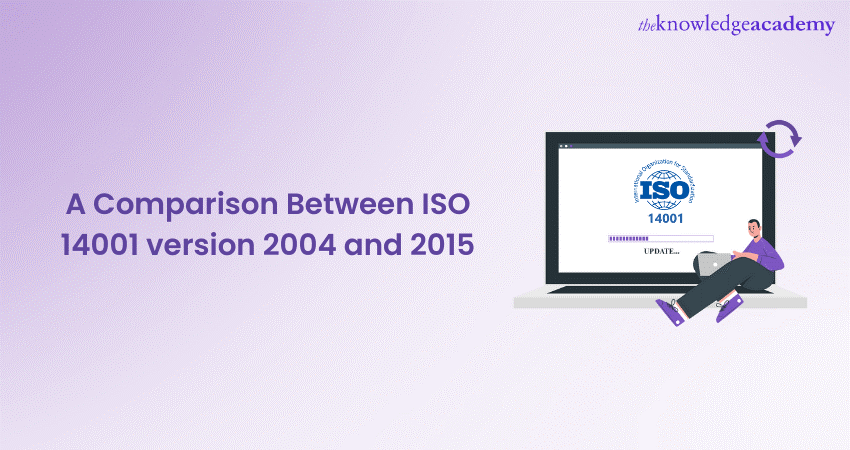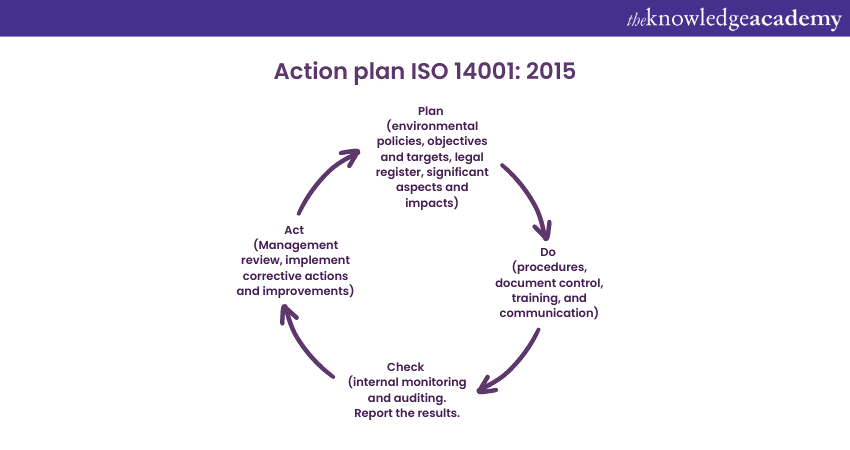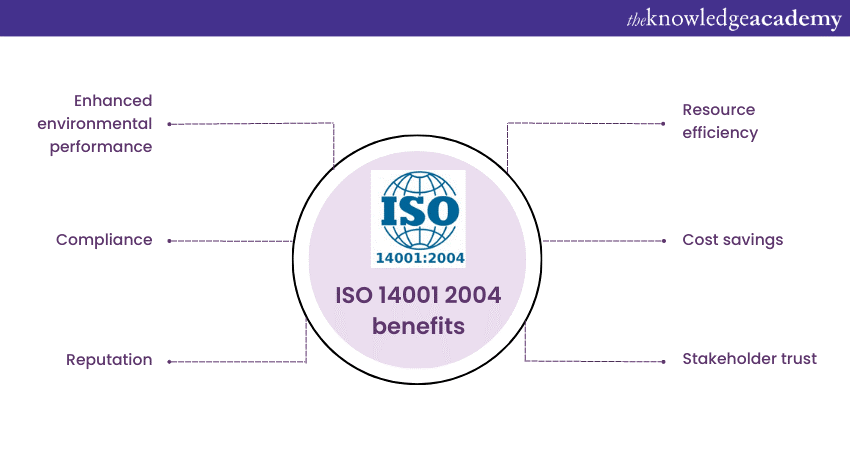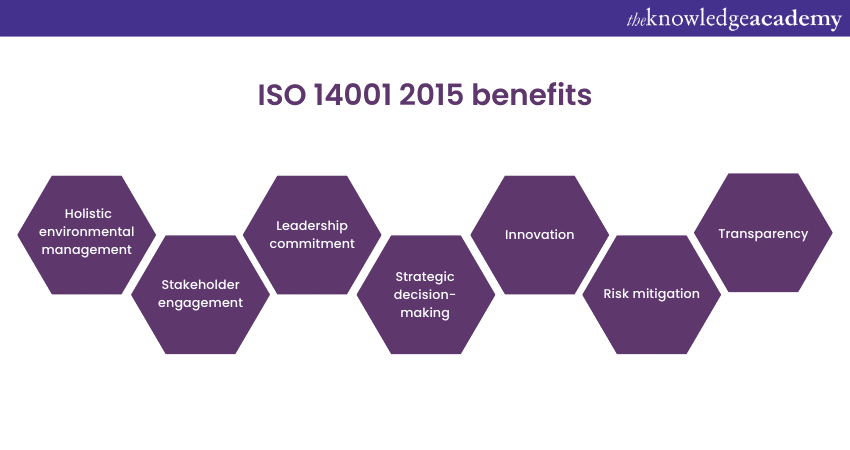We may not have the course you’re looking for. If you enquire or give us a call on +1 7204454674 and speak to our training experts, we may still be able to help with your training requirements.
Training Outcomes Within Your Budget!
We ensure quality, budget-alignment, and timely delivery by our expert instructors.

ISO 14001 Version 2004 vs 2015: It shows us the steps upward in this aspect of Environmental Management between these editions of the same play. ISO 14001:2004 and ISO 14001:2015 are two editions of the international norm that regulates Environmental Management Systems (EMS). The 2004 and 2015 versions of the document assist businesses in enhancing their environmental performance, complying with laws, engaging with stakeholders, and achieving sustainable development.
ISO 14001 model is ISO 14001 integrated model has been accepted in more than 150 countries worldwide. Through the implementation of ISO 14001 Risks and Opportunities, environmental institutions would be able to increase their prospects for a better future. This blog will uncover distinctions between the Environmental Management ISO 14001 Version 2004 vs 2015 standards and their impact in optimising your organisation's practices.
Table of Contents
1) Overview of 14001:2004
2) Overview of ISO 14001:2015
3) Key Differences between ISO 14001:2004 and 2015
4) Similarities between ISO 14001 Version 2004 and 2015
5) ISO 14001 2004 benefits
6) ISO 14001 2015 benefits
7) Conclusion
Overview of ISO 14001:2004
Under the terms of 14001 ISO standard lies the basis for implementing EMS (Environmental Management System) is defined, allowing an organisation to adopt a policy, establish targets and objectives in environmental area and meet its legal and other requirements. It serves as a stimulus to guide managers on various elements of organisational environment management. It offers assistance on how to measure environmental performance as well as applicable management strategies.
The most important feature within ISO 14000 family is that ISO 14001 is the only standard ISO certifiable. In addition, it follows the PDCA (Plan-Do-Check-Act) methodology whereby it involves planning, executing, evaluating, and improving processes.
Overview of ISO 14001:2015
ISO 14001:2015 demonstrates the involvement of the ISO 14001 Life Cycle to support the services to ISO 14001. It provides tools that assist organisations in coming up with environmentally friendly alternatives, that is, being resource-efficient and preventing pollution. The standard, however, involves Leadership and stakeholders to encourage effective decision-making in the businesses involved.

ISO 14001:2015 is designed to be easily integrated with other management system standards. By adopting it, organisations can improve their environmental performance, reduce risks, and show their dedication to sustainable practices.
Understand the ISO 14001 structure efficiently with our ISO 14001 Internal Auditor Course. Join now!
Key Differences between ISO 14001:2004 and 2015
The most recent iteration of ISO 14001, ISO 14001:2015, introduces alterations to the predominant standard concerning Environmental Management Systems (EMS). Among these changes, a prominent adjustment lies in its framework. ISO 14001:2015, a high-level cladding, called as Annex SL, was conceived as the standard attached to all ISO management system standards including ISO Environmental Aspects and Impacts.
This unified format also improves the strategic goals to the standard and simultaneously coordinates it with other management system ISO standards. Beyond this structural update, numerous disparities exist between ISO 14001: 2004 and 2015. The subsequent pointers will focus on summarising the major disparities:
Organisational context
ISO 14001:2004:
a) Focuses on understanding the organisation's environmental aspects and impacts.
b) Does not explicitly address the organisational context.
ISO 14001:2015:
a) Requires organisations to identify internal and external issues that impact their Environmental Management.
b) Considers the organisational context, including its social, cultural, and economic aspects.
Needs and expectations of interested parties
ISO 14001:2004:
a) Does not explicitly emphasise identifying and addressing the needs and expectations of interested parties.
ISO 14001:2015:
a) Requires organisations to identify and understand the needs and expectations of interested parties.
b) Encourages organisations to engage with Stakeholders and address their concerns.
Leadership and commitment
ISO 14001:2004:
a) Focuses on the establishment of an Environmental Management System without specific emphasis on leadership and commitment.
ISO 14001:2015:
a) Emphasises leadership engagement and commitment to Environmental Management.
b) Requires top management to demonstrate leadership in establishing and integrating Environmental Management practices.
Life cycle perspective
ISO 14001:2004:
a) Does not explicitly require organisations to consider the entire life cycle of products and services.
ISO 14001:2015:
a) Encourages organisations to adopt a ISO 14001 Life Cycle Perspective when identifying environmental aspects and impacts.
b) Considers all stages of a product or service, from raw material acquisition to end-of-life disposal.
Environmental performance
ISO 14001:2004:
a) Focuses on monitoring and measuring environmental performance without specific guidance on improvement.
ISO 14001:2015:
a) Requires organisations to set objectives and targets for improving their environmental performance.
b) Emphasises proactive initiatives to enhance environmental performance and achieve sustainable outcomes.
Communications
ISO 14001:2004:
a) Does not explicitly emphasise communication of environmental performance or engagement with stakeholders.
ISO 14001:2015:
a) Requires organisations to establish a communication process for internal and external stakeholders.
b) Emphasises the importance of transparent and Effective Communication regarding environmental performance and management efforts.
Boost your environmental impact with ISO 14001 Courses! Master sustainability and enhance compliance.
Similarities between ISO 14001 version 2004 and 2015
While ISO 14001:2015 introduces updates and enhancements, organisations familiar with ISO 14001:2004 will find many similarities when transitioning to the newer version. The similarities include:
a) Both versions focus on establishing an effective system to manage environmental aspects and impacts.
b) Both versions use the Plan-Do-Check-Act cycle for continuous improvement in environmental performance.
c) Both versions require organisations to have an environmental policy showing their commitment to environmental protection and improvement.
d) Both versions emphasise Compliance with applicable environmental regulations.
e) Both versions require setting specific goals to improve environmental performance.
f) Both versions emphasise providing training and ensuring employees have the necessary skills for Environmental Management.
g) Both versions require maintaining document control ISO 14001 related to the EMS.
h) Both versions require periodic reviews by top management to assess the EMS's effectiveness.
i) Both versions promote an ongoing commitment to improving environmental performance.
ISO 14001 2004 benefits
ISO 14001:2004 offers several unique benefits for organisations striving to improve their Environmental Management practices. By implementing ISO 14001:2004, organisations can:
a) Enhance environmental performance and minimise their impact on the environment.
b) Improve resource efficiency and reduce waste generation.
c) Comply with environmental regulations and avoid penalties or legal issues.
d) Boost their reputation by demonstrating commitment to environmental responsibility.
e) Gain a competitive edge by meeting customer expectations for sustainable practices.

f) Increase Employee Engagement and morale by fostering a culture of environmental awareness.
g) Identify and mitigate environmental risks, minimising potential incidents or accidents.
h) Achieve cost savings through improved energy efficiency and waste management.
i) Enhance stakeholder trust and build strong relationships with customers, suppliers, and the community.
j) Foster innovation and creativity in finding sustainable solutions.
Learn the fundamental principles of Environmental Management with our ISO 14001 Lead Implementer Course. Sign up now!
ISO 14001 2015 benefits
ISO 14001:2015 brings a fresh set of unique benefits for organisations committed to Environmental Management and sustainability. By adopting ISO 14001:2015, organisations can:
a) Foster a holistic approach to Environmental Management by considering the overall life cycle of products and services, from procurement to disposal.
b) Improve stakeholder engagement by actively involving interested parties in environmental Decision-making Processes.
c) Strengthen leadership and commitment to environmental sustainability throughout the organisation, driving a culture of responsibility.
d) Enhance strategic decision-making by aligning Environmental Management with the organisation's overall business objectives.
e) Improve communication and transparency by effectively sharing environmental performance information with internal and external stakeholders.

f) Promote innovation and creativity in finding sustainable solutions, encouraging organisations to explore new approaches and technologies.
g) Ensure compliance with environmental regulations and minimise the risk of penalties or legal issues.
h) Drive continual improvement in environmental performance by setting measurable objectives and targets.
i) Enhance reputation and brand value by demonstrating a proactive and forward-thinking approach to environmental responsibility.
Achieve long-term cost savings through resource efficiency, waste reduction, and energy conservation.
Conclusion
We hope this blog was instructive in regard to ISO 14001 Version 2004 vs 2015. ISO 14001:2004 and ISO 14001:2015 aid organisations with Environmental Management, add a new dimension into innovation, and show initiative adhere to sustainability. They provide advantage, interact with the holders of the stake, and contribute to sustainability at the same time. Being compliant with the ISO 14001 standard allows an organisation to take responsibility and actively erase the negative aspects of their business practices from society.
Master our ISO 14001 Training for sustainable Environmental Management. Join now to make a difference!
Frequently Asked Questions

Besides the record-breaking speediest processing, the ISO 14001 2015 introduced new features which are marked by involvement rather than evasion, in the environment field. It widens the horizon of concern, heightens the role of leadership in that process, advocates risk-based thinking, and makes an alignment with strategic objectives.

The Knowledge Academy takes global learning to new heights, offering over 30,000 online courses across 490+ locations in 220 countries. This expansive reach ensures accessibility and convenience for learners worldwide.
Alongside our diverse Online Course Catalogue, encompassing 17 major categories, we go the extra mile by providing a plethora of free educational Online Resources like News updates, Blogs, videos, webinars, and interview questions. Tailoring learning experiences further, professionals can maximise value with customisable Course Bundles of TKA.

The Knowledge Academy’s Knowledge Pass, a prepaid voucher, adds another layer of flexibility, allowing course bookings over a 12-month period. Join us on a journey where education knows no bounds.

The Knowledge Academy offers various ISO 14001 Certifications, including the ISO 14001 Foundation Certification, ISO 14001 Lead Auditor Course, and ISO 14001 Internal Auditor Training. These courses cater to different skill levels, providing comprehensive insights into the ISO 14001 Audit.
Our Health and Safety Blogs cover a range of topics related to ISO 14001, offering valuable resources, best practices, and industry insights. Whether you are a beginner or looking to advance your ISO 14001 skills, The Knowledge Academy's diverse courses and informative blogs have got you covered.
Upcoming Health & Safety Resources Batches & Dates
Date
 ISO 14001 Foundation Certification
ISO 14001 Foundation Certification
Mon 9th Dec 2024
Mon 13th Jan 2025
Mon 17th Feb 2025
Mon 21st Apr 2025
Mon 23rd Jun 2025
Mon 18th Aug 2025
Mon 20th Oct 2025
Mon 15th Dec 2025







 Top Rated Course
Top Rated Course



 If you wish to make any changes to your course, please
If you wish to make any changes to your course, please


